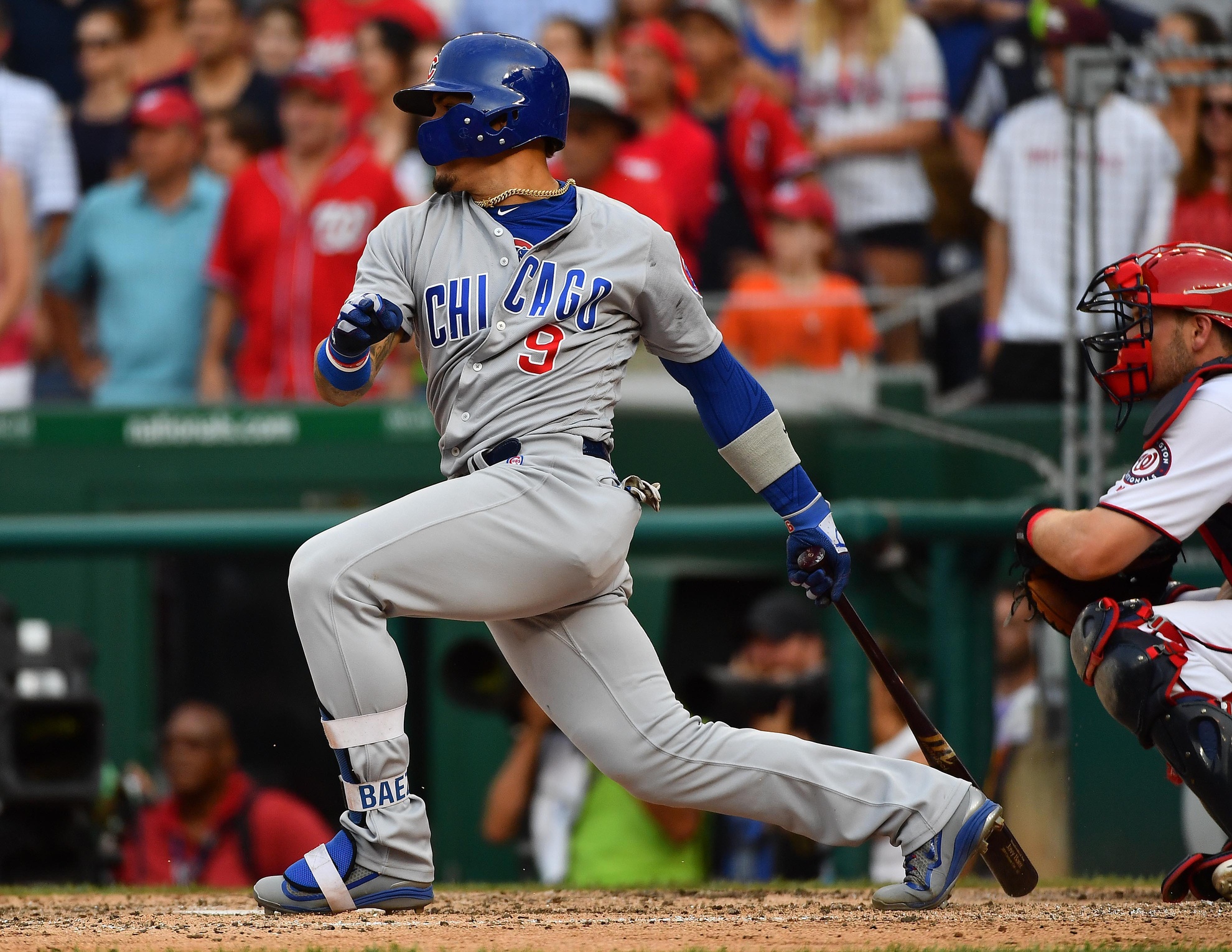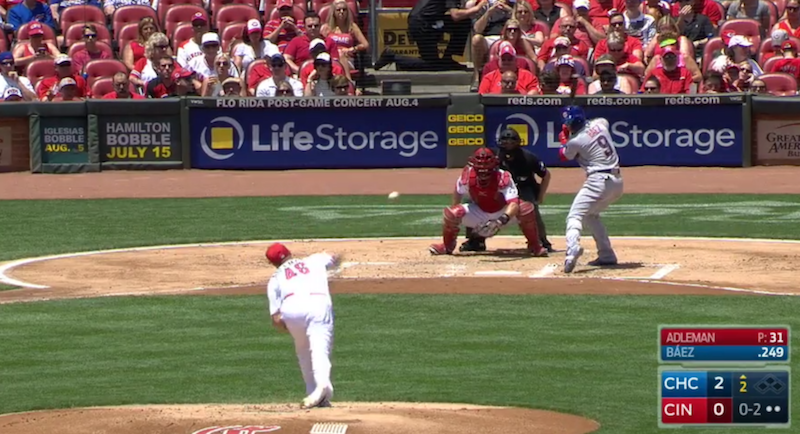Javier Baez had a really nice game in Sunday’s series finale against the Cincinnati Reds. The next time the Cubs take the field, Javier Baez might have a not-as-nice game. Such is the life with a player that possesses both enormous upside and fundamental flaws in his approach and his mechanics. Just when you think he may be turning a corner in certain respects, he’ll turn around and look overmatched at the plate. Of course, his defense and everything that goes along with it (hands, instincts, swagger, etc.) help to compensate for a lot, but at some point we’re going to have to witness visible growth at the plate from Baez. And while some of the early returns have not given a lot of reason for optimism, he has made a small change in his approach that might be cause for high hopes.
First, a look at what he’s done so far this year:
| PA | AVG | OBP | K% | BB% | ISO | BABIP | TAv | WARP |
|---|---|---|---|---|---|---|---|---|
| 245 | .249 | .290 | 26.1 | 5.3 | .196 | .301 | .256 | 0.3 |
Each of those numbers represent a decrease from 2016 or, in the case of the strikeout rate, an increase. The only number that has actually demonstrated improvement is the walk rate, which has “jumped” all of two percent. Certainly not working in his favor is an opening month where he hit .203, while reaching base at a rate of only .262. FanGraphs had his wRC+ in that first month at just 67. So it’s certainly important to note that he’s demonstrated improvement since getting off to a slow start to the year.
Of course, with Baez it’s always essential to examine the plate discipline and contact trends. Given his reputation as perhaps the freest of swingers, there may not be a bigger wild card in the sport than those figures from Baez on a given day. Nonetheless, here they are, measured against the same figures from 2016:
| O-Swing% | Z-Swing% | Swing% | Z-Contact% | O-Contact% | Contact% | Soft% | Hard% | SwStr% | |
|---|---|---|---|---|---|---|---|---|---|
| 2016 | 41.9 | 64.6 | 51.8 | 81.1 | 58.3 | 70.8 | 18.7 | 29.1 | 14.4 |
| 2017 | 40.0 | 71.6 | 53.8 | 76.5 | 44.6 | 63.2 | 21.0 | 32.3 | 18.9 |
While it’s somewhat encouraging to see that his overall swing rate hasn’t increased too much, and his Swing% on pitches outside of the strike zone has actually decreased, there’s nothing particularly exciting about a leap in his zone swing percentage combined with a rather drastic decrease in his contact rate on pitches inside of the strike zone. However, just like Baez’s overall statistics on the season don’t necessarily tell the whole story, given the slow start, such is the case here as well.
The month of April featured an overall contact rate of just 55.3 percent, which was followed up by a 72 percent mark in May and 65.1 in June. His whiff rate has also fallen significantly since an April in which he hacked and missed at 24.4 percent of pitches. He fell right in at about 17 percent combined over the next two months. Additionally, his Hard% has increased in each of those first three months, moving from 30 percent in April, to 30.6 in May, before leaping to 37.7 in this past month.
It’s that June that has me relatively intrigued about Baez, his approach, and his mechanics moving forward. That intrigue doesn’t necessarily come from a statistical standpoint, either, as it did represent a decrease from a lot of what he put on the stat sheet during the month of May. For example, one interesting element of Baez’s June is that he went to the opposite field 26.4 percent of the time, representing about a 10 percent increase from the previous month. In pitchers’ counts (1-2, 0-2), Baez is taking the ball to the opposite field at a 29.6 percent rate. That certainly would seem to indicate that he’s shortening up and putting the ball in play, however he can.
And while the stats don’t necessarily back it up quite yet, there’s a clear change taking place in Baez’s approach at the plate. In addition to that increase in Oppo%, he does also appear to be working on eliminating that high leg kick in certain instances, especially deeper into counts. This was something that was especially prominent in the series against Cincinnati.
That seems like a fairly significant development in Baez’s swing. That lower leg kick/stride is something that we saw constantly across the three-game set in Cincinnati. Previously, it had been more noticeable in two-strike situations, but there isn’t necessarily a downside to Baez adapting it to his swing full-time. High leg kicks have a tendency to disrupt timing in some swings, and that could very well have been (and continue to be) contributing to high whiff numbers with Baez, in addition to his lack of selectivity at the plate. Simplifying and shortening up (and in some cases choking up, which was also showcased a bit against the Reds) the overall swing has the potential to pay major dividends for Javier Baez at the plate.
Baez has visibly demonstrated a willingness to work on his swing. There have been adjustments in hand placement and *some* pitch selection aspects that he’s made throughout his time at the big league level. This abbreviated stride could be another way of bettering Baez as an offensive weapon. This is one way of potentially increasing his ability to make contact more regularly. If you increase his ability to make contact, you make him an exponentially more dangerous offensive player, given his absurd level of power.
Not that this will go a terribly long way toward eliminating those free-swinging tendencies or his penchant for trying to put the ball in the seats. Those may be elements of his game that we’ll have to continue to bear as he continues to refine his approach and mechanics. And that’s really one of the important elements of studying Javy Baez: accepting him with his flaws included.
He’s going to have lapses in his approach at the plate. He’s going to have those moments where his eyes are set on putting the ball in the seats. That high leg kick won’t disappear forever, just as the aggressiveness won’t. But the fact that we’re seeing these small tweaks in his approach, both in the opposite field tendencies and in the apparently adjusted stride leave hope that he’ll make himself a more consistent threat at the plate.
We know what Javy Baez is capable of, with his glove, his arm, and his bat. Any one of those three aspects can turn a game on a dime. From an offensive perspective, it’s a matter of honing all of that ability into something more consistent. And the awareness and willingness to work that Baez continues to demonstrate is an awfully encouraging sign moving forward. Even if it isn’t immediately reflected on the stat sheet, the signs are there and the growth is evident, however slowly it may progress.
Lead photo courtesy Brad Mills—USA Today Sports


Given Javy’s swing tendencies is hitting before the pitcher and the associated temptation to expand his strike zone the best slot for him?
Although entirely different hitters, this made me think of Starlin’s inconsistencies and how we perceived them. Javy has the benefit of a much better club and competing “problems” among WarBear, Addy and Jake – so perhaps he would have been buried in negative press (and taeks) were this another era, but unlike Castro – Javy’s ability to improve – while not nearly as amazing in jumps his first two years – have me on Joe’s “superstar” bandwagon.
Javy seems to truly thrive on emotion and I’m hoping the WS and WBC hangovers account for the bad start.
Given Javy’s swing tendencies, especially his willingness to expand the strike zone late in the count, does batting him in front of the pitcher make sense for him or the overall lineup?